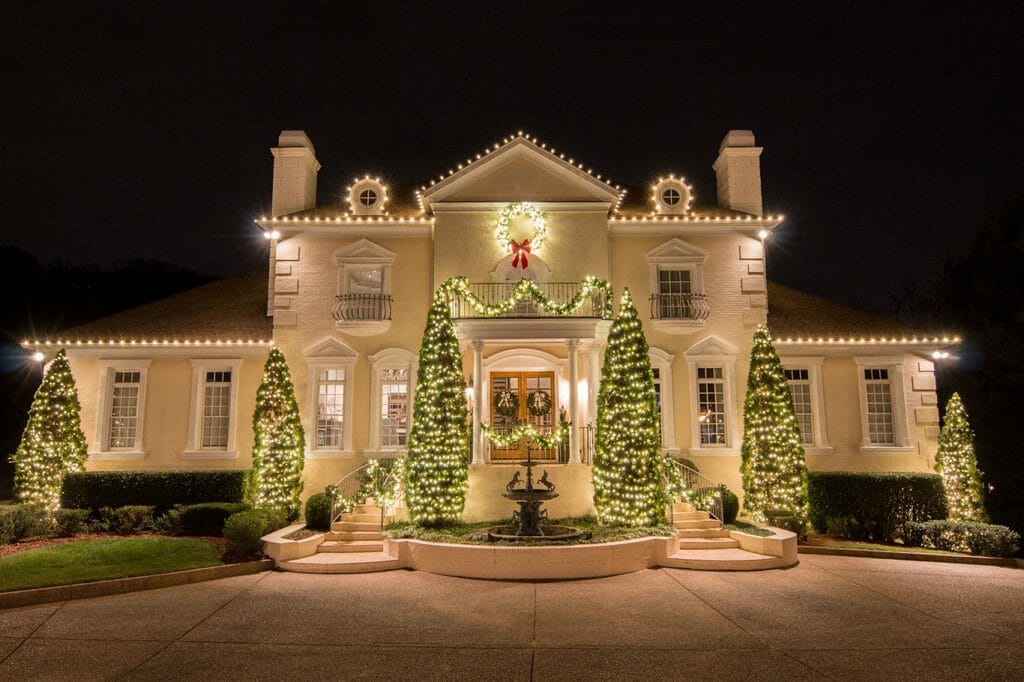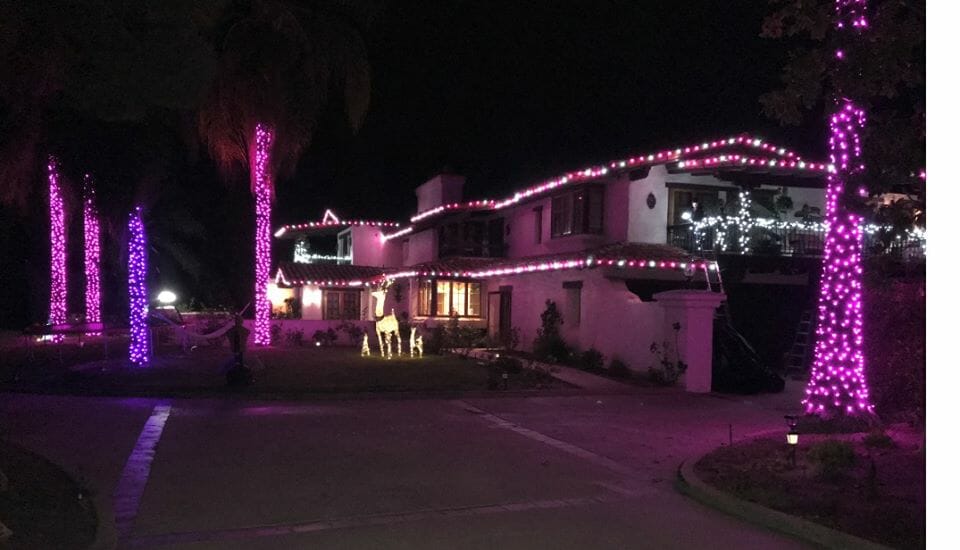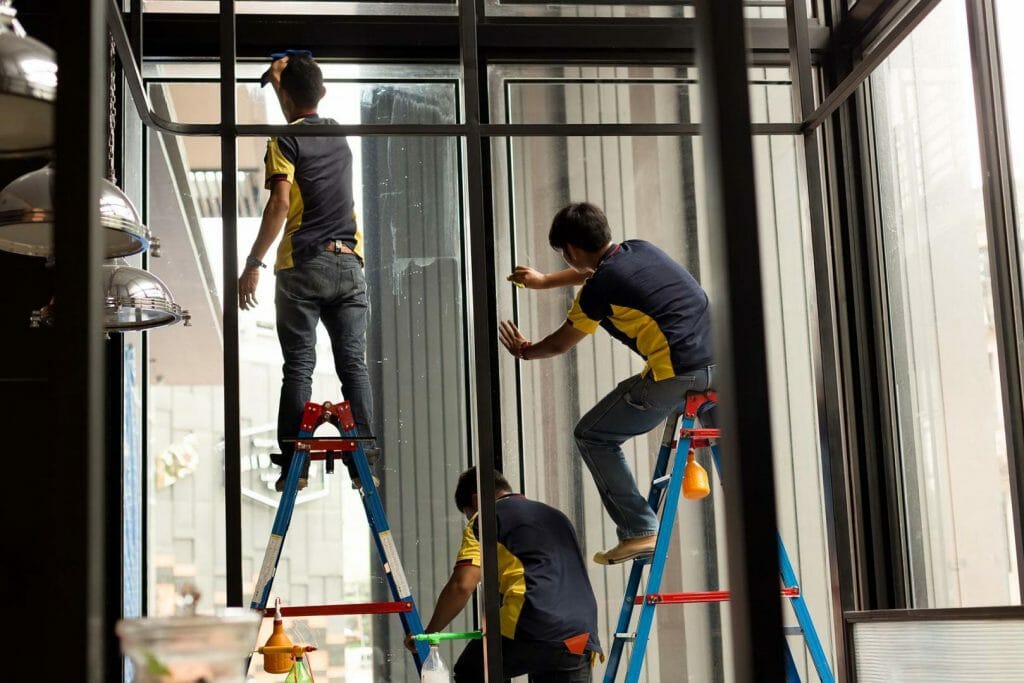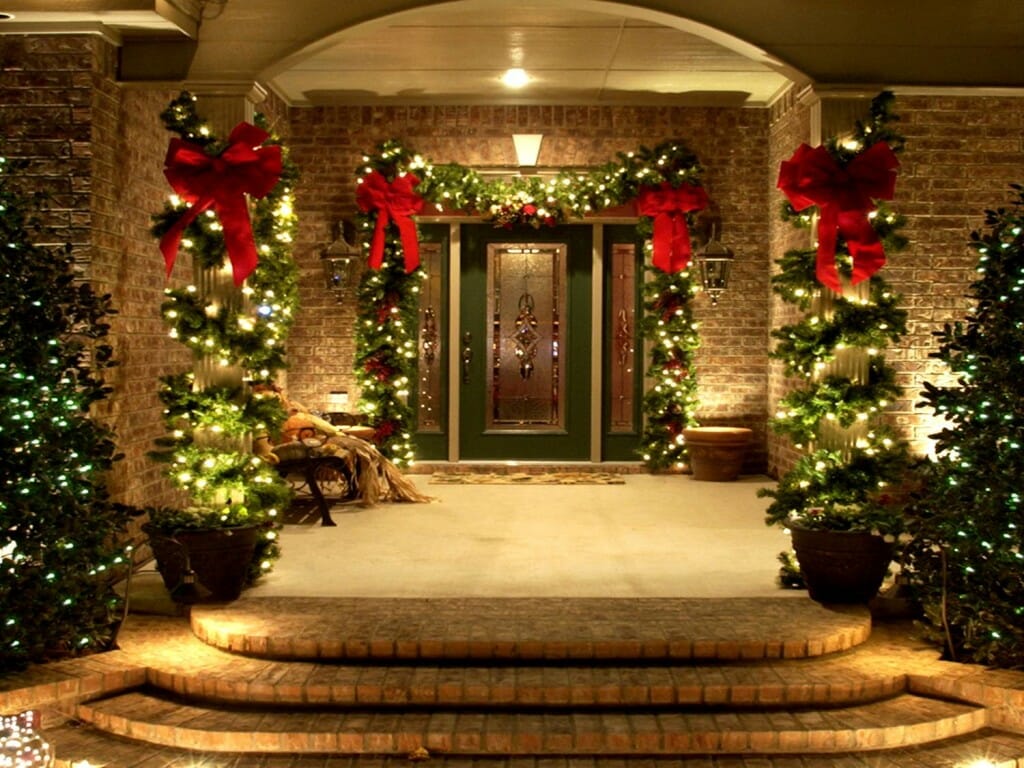For many of us, the thought of getting out the ladder, lights, and extension cords…

The holiday season is a magical but chaotic time jam-packed with school recitals, office parties, gift shopping, visiting family, trimming the tree, and many other beloved traditions. With so much going on, most people don’t have the time or energy to think about decorating their homes for the holidays. Going online to research the latest trends, styles, and safety procedures takes precious hours that could be spent with loved ones.
We’ve created this comprehensive holiday lights guide to make decorating easy. It covers everything you need to know, from hiring professionals to troubleshooting light strands.
Why hire a professional to install my lights?

Great question (and great movie). There are reasons for and against, but first, let’s think about the THREE major benefits of hiring a professional to install your holiday lights and /or decorations.
Reason #1: Time
The biggest reason our clients report that they came looking for a professional to begin with is time. During one of the busiest and most stressful times of the year, the last thing people want to do is give up a precious weekend or take a day off work to pull that dusty ladder out of the garage that you’ve used twice in your life and lean it precariously against their house. Most people don’t want to test their arachnophobia by opening up that cardboard box that’s been sitting on the attic shelf since January either. We all know what Murphy’s Law dictates when you plug those tangled old light strands in that you bought at Target last year – they never work.
If you’re planning to do it yourself, count yourself down for at least half a day of wrangling up the gear and functional lights you need before you can even start to hang them on your house. By employing a professional light installer, you get that Saturday back to spend with your friends and family and with it leave out all the accompanying stress and headaches. Getting this time back, for many people, is invaluable.
Reason #2: Quality
The second most stated reason for hiring a professional holiday lights installer is the quality of the work. Have you ever driven down a street and seen two houses with Christmas lights and one just looked…off? Or maybe you’ve hung holiday lights on your own home, and even after hours of adjusting and tweaking, twisting and pulling, they just don’t quite make your home look like that winter wonderland that Pinterest promised. And no, you are not fooling anyone by stuffing the extra six feet of lights into your gutter on the corner of your house. We get it – making lights look good is hard. Good professional light installers know the tricks of the trade, and they also use commercial grade lights that are easier to manipulate to the custom contours and shape of your home. You can’t always do that with those mismatched boxes of lights you got for 40% off at Wal-Mart the day after Christmas. A quality light installation yields not only sharp and professional-looking lights on your home, but also well-performing lights. Something about a house decked out with Christmas lights just doesn’t look right when only half of the lights are working.
Reason #3: Safety
Another reason to hire a professional lighting company is SAFETY. There can’t be enough said about doing this safely. Each year there are over 15,000 injuries related to holiday decorating in the US alone! Much of these are due to homeowners doing things they don’t normally do and are not trained to safely do – namely, climbing on ladders and scurrying across roofs. Throwing some lights on the bushes can be done by almost anyone, but when it comes to climbing up to the roof of a 2nd or 3rd story home, safety can not be underestimated. The proper equipment and the necessary training must be taken to ensure a safe experience and most homeowners do not have either. So instead of risking themselves or their spouse spending their holidays with a sprained knee, or worse, many homeowners choose to hire a professional Christmas lights installer.
So, taking into consideration those 3 reasons, why would anyone want or need to install their lights themselves instead of hiring a professional?
The primary reason people choose to do it themselves is if they’re on a tight budget. Hiring a high-quality professional Christmas light installer is not cheap. We’ll get into pricing in more detail a little later in the guide, but the gist of it is that they:
- Use commercial grade lights – no cheap-o fairy lights from the dollar store.
- Employ qualified installers who are trained specifically for this work.
- Are severely time-constrained – no one wants holiday lights installed on September 1st or December 26th so installers’ hours are long and days-off few and far in between.
- Insurance for workers on high ladders and roofs is very expensive.
Prices vary depending on where you live, but if you’re looking to hire a high quality experienced holiday lights installer for a basic Christmas lights setup, you shouldn’t expect to pay less than $600.
Another reason people will install their Christmas lights themselves is if they have a simple home or expect to do very minimal and accessible decorations. For example, If you have a 2 story, 4,000 sq. foot home and you want lights all along the rooflines – good luck, but if you only want lights on a couple of bushes in your front yard, that may be a manageable enough task for you.
So at this point you know enough to determine whether you want to hang your lights yourself, or hire a professional. If you’re in the former group, have fun, be safe and skip down to the bottom of this guide if you have any issues. If you’re in the latter – great! Let’s think about how to compare different holiday lights installers when you’re looking to hire a pro.
The first thing you need to understand is that not all installers are created equal. Just like in other areas of your home – window cleaning, gutter cleaning, roof cleaning, pressure washing, do you really want someone ‘experimenting’ on your most valuable asset?
How do you tell if someone has experience? Ask them how many jobs they do each year – residences and commercial properties. Ask them to name a property they’ve done before. An experienced installer who is confident in their quality will give you references that you can call. You can also ask contractors how they do the installation and what type of materials they use – the more comfortable and open they are in talking about it the better.
The second thing you can use to compare professionals for holiday lights is if the type of lights they offer. Typically contractors fall into one of 3 buckets here:
#1 Those that primarily hang customer owned lights
Some homeowners may just need a helping hand with their lights and nothing else. In that case, hiring a professional that only hangs customer lights is preferred. These contractors are usually skilled in handling numerous different styles of lights and can make do with the lights you have. While this is not necessarily always the case, this bucket is where lower-skilled or newer installers tend to fall. So if you’re hoping to do more technical or complicated decorations (e.g., automated lighting displays, cafe style lights, etc.) these contractors are probably not your best bet.
#2 Those that hang both customer and their own lights
Most pros end up in this bucket – offering the option of using your own lights or using their lights. Some will even allow installing your lights on some parts of the property and their lights on others. These pros can be a great choice for homeowners looking for more flexibility on the style and design of their holiday lights.
#3 Those that hang only their own (typically custom) lights
This bucket is where you’ll find the smallest number of contractors. By only offering their own lights, options and styles are sometimes limited. However, since these pros only work with a few types of lights, they are intimately familiar with them and they are often able to tackle larger, more complicated jobs.
Part of choosing a pro from one of the above buckets is situational – if you have your own lights that you want to use, you can narrow down your search to buckets #1 and #2. If you don’t have lights, pros from buckets #2 and #3 typically offer options to either purchase or lease custom lights from them. This is often a source of confusion for many homeowners, so let’s dig into it:
Purchase:
In this case, the pro will provide new custom cut, commercial-grade lights and install them on your home and once they are installed, they are now your lights. This typically means your price in future years will be lower. Maintenance and upkeep for the first season are usually included, but usually, breakages and bulb outages after that will typically be charged to you the customer. Installers differ on who stores the lights after the season, since they are owned by the customer. More on that in our takedown section. When evaluating bids from pros, make sure to ask if your purchase of the lights is limited to the lights themselves or if it includes accessories (e.g., extension cords, timers, etc.).
Lease:
The other common option is for pros to lease the lights to the homeowner. This means that the installation company retains ownership of the lights while the homeowner is just using them for the season. This means that the price will be very consistent year to year. Maintenance of breakage and bulb outages are almost always included in the leasing price. Leased lights are typically stored by the installers off-site – so you don’t have to worry about that. Leasing lights allows the homeowner to change designs or colors from year to year without any significant price changes.
Insurance & Guarantees
Once you’ve narrowed down the playing field to those Christmas light installers that have proper experience and offer the lighting styles and choices you want, the next big piece you’ll want to look for is insurance. This is not necessarily the most interesting or exciting thing to think about, but choosing a holiday lights installer with the wrong type or no insurance at all is a big mistake you’ll want to avoid. So what type of insurance do you need from a professional installer? 2 types:
General Liability:
Referred to as GL insurance, this is a basic insurance that covers damage relating to accidents during the course of work performed. Let’s say a contractor drops his ladder and smashes the roof of your brand new Tesla – GL insurance will cover it. Ask the pro to see a copy of their Acord insurance certificate and make sure it has a policy number and is not expired. If you are particularly cautious or having the installer work on a commercial property, your safest bet is to have them add you as an ‘additional insured’. They can get this same Acord certificate from their insurance company with your name and address on it to ensure you are covered in the event of a loss.
Workers’ Compensation:
While most pros worth their salt will have GL insurance, fewer have workers compensation (WC) insurance. This protects the employees of the installing company in case they get hurt on the job – whether that means a sprained ankle or a broken bone or worse, WC insurance will cover medical charges and lost wages. While the law generally requires that contractors carry WC insurance, a surprising number still don’t. A big reason for this is that it can be very expensive – precisely because installing Christmas lights is dangerous and the risk of an accident is unusually high.
Before you let any holiday lighting installation company set foot on your property, you should require they show you valid certificates for both. Without both, you could leave yourself open to unnecessary risk. If they can’t produce one or both of these, you should move on to the next pro.
Lastly, before you settle on a particular Christmas light installer for your home or business, you should inquire about their guarantee. Do they even have one? Contractors who install customer-owned lights may provide more limited guarantees since they can’t vouch for the quality of the lights themselves, but it’s important to understand their guarantee nonetheless. For installations using custom / provided lights, the installer should guarantee the lights throughout the season. Any issues during the season will be much easier for them to troubleshoot than someone unfamiliar with their lights.
Choosing Decorations
Now that we’ve explored the options regarding choosing a professional to install your home’s Christmas decorations, let’s shift gears and look at the materials themselves. When it comes to holiday lights, Christmas wreaths, and garland, the options are seemingly endless. To help you cut through the clutter, we’ll break it down and go through the most popular styles and types of lights and other decorations available to help you decide which is best for you and your home.
Mini Lights
The most popular style of Christmas lights are referred to as mini lights. These come in a multitude of different sizes, shapes and lengths. Prior to the widespread introduction of LEDs, the ubiquitous style of minis was small ~.4” incandescent glass bulbs on dark green wire. Now that LEDs are becoming more commonplace, the options available to consumers have ballooned, with numerous bulb sizes, colors, and lengths readily available. Mini lights can be used in almost any setting, depending on taste, from trees and bushes, to porch railings, on garland and wreaths, and even along roof and gutter lines.
C7 & C9 lights

C7 and C9 lights are both a very traditional, single bulb lighting style and are the most common type of roofline lights. The bulbs are spaced at consistent intervals of anywhere from 6” to 18”, depending on the manufacturer. The 2 core differences between C7 and C9 lights is their size and brightness. C7 bulbs measure ~1” wide and 2¼” long while C9s are slightly larger at ~1¼” wide and 3” long. C9s are also brighter as the incandescent versions have larger filaments and draw more power and the LED versions typically pack in additional diodes for more light. This style of lights is made in most solid colors and even RGB (red, green, blue LEDs) that can create up to 16 million hues of light color. While these are typically installed on roof lines and gutters, they are also occasionally used on larger trees and bushes.
Icicle Lights

Icicle lights, a relatively recent addition to the Christmas decoration scene, are another popular choice. Designed to look like real icicles, they incorporate one solid strand of mini lights with shorter additional strands that ‘drop’ at fixed intervals to create the illusion of real ice when installed on a gutter or roofline. The length, color, size of bulb, and distance between drops varies by manufacturer. Some models even incorporate ‘chasing’ features with the lights turning on and off at distinct times to give a ‘dripping’ effect off the icicles. This style tends to elicit strong reactions from people – either you love them or you hate them.
Rope Lights

While not typically considered a traditional Christmas light style, rope lights nonetheless feature prominently in an increasing number of holiday light displays. Rope lights feature a series of incandescent or LED bulbs inside a plastic casing and give the appearance at night of a steady beam or ‘rope’ of light. Rope lights can be installed in a number of places, including gutters and roof lines, porch railings, landscaping, and even wrapped around trees. Colors are varied, but typically incandescent versions have white light while some LED rope lights offer full RGB color capabilities.
Garland & Wreaths
Traditionalists swear by the classic look of greenery in the form of tastefully applied garland outlining a porch or railing and wreaths hung at various points on the front of a home. Greenery can be either lit or unlit, and while both are popular, the former is more commonly seen on homes.
Greenery can also be live or artificial and homeowners are often unsure of how to choose between the two. Live or authentic garlands and wreaths are commonly made from branches of pine or fir trees, often accented with pine cones and other decorative elements. Purists argue that real greenery is the way to go, citing aroma and the authentic look as compared to some artificial garlands and wreaths. Artificial greenery, however, has numerous benefits that have led it to become more popular than authentic greenery. The primary benefit of artificial is that it is, with proper care and storage, reusable year after year versus having to purchase live greenery each year. It is also much more resilient to weather than real greenery. While those in colder climates won’t have to worry about this, warm weather climates with strong sunshine throughout the winter can cause authentic greenery to wilt and / or turn brown – becoming a decidedly unattractive holiday decoration.
Lasers & Miscellaneous
Outside of the traditional holiday decorations, many homeowners look for ways to add unique decorative elements their home. Plastic figurines, such as Nativity scenes, snowmen, or Santa Claus statues continue to populate on the lawns of homes throughout the country, however a small but growing contingent of homeowners are looking to newer ‘toys’, specifically lasers. Designed specifically for holiday decorations, but usable year round, lasers come in the form of a small black projector that looks like a small landscape light. The laser itself is refracted, projecting thousands of small dots or holiday themed designs onto a house or trees / shrubs, giving a very unique look. Various colors and themed designs are available, depending on the manufacturer. While lasers are becoming more common in homeowners’ holiday decorations, they do not appear to be poised to replace traditional holiday lights altogether, but rather accent them.
Another twist to traditional holiday decorations is automated lighting displays. These are simply systems that control any kind of lighting decoration, to turn on and off to create effects that typically coordinate with music. Automated displays range widely in complexity and cost. Basic displays can be setup on by weekend warriors, however more elaborate designs are best left to lighting experts and engineers.
Cost of Christmas Lights: Rent vs. Buy
One of the big considerations when considering holiday lights is whether to rent/lease or buy. There are several factors that must be considered when making this decision. First, are you someone that likes to use the same style year after year? Or do you prefer to change up your decorations each year. If you are someone that tends to switch up designs then buying is likely not a good solution. At the same time, if you do prefer a “look” and feel that it will remain constant, you may want to purchase your holiday lights.
If you do purchase lights, we recommend buying commercial lights that will give you years of enjoyment. Incandescent lights and even some LED lights purchased from your local retailer will likely not last more than a season or two. Since the lights can be a substantial investment, purchase commercial grade. We buy from a distributor but you can find a local dealer with a quick internet search.
Remember that if you purchase the lights you will have to maintain them. This means having storage bins, a storage area, and the ability to fix / replace whatever breaks from season to season. If you don’t want the hassle, then simply lease the lights. You will pay more, but you will not have to worry about all the maintenance questions that inevitably arias.
In terms of the cost of running your lights, think of LED lights kind of like a couple TVs running in the home. The electrical requirement is low. We recommend setting the timers so that they come on at dusk and go off around midnight. This gives you and your neighbors plenty of time to enjoy the light without wasting energy running lights at 2 or 3 in the morning.
Troubleshooting
Inevitably, part of or all of your light display will stop working at one point or another during the season. This is an expected outcome of placing small plastic electronics outdoors in the winter elements and leaving them there for 2+ months. Now that your expectations are set, let’s dive into some common issues with holiday lights and tips for fixing them. Most issues with lights come down to a simple conclusion: they’re not coming on. So let’s take a look into what might be causing that.
Power issues
A very common problem with Christmas lights is when a homeowner’s entire display / house will suddenly turn off or won’t turn on one day. If this happens, you can be fairly certain that you have a power issue. More often than not, this is because the outlet where the lights are plugged in is simply not providing any voltage. So the first step in troubleshooting here is to check to see if the outlet is on – you can do this by plugging a simple device such as a phone charger or similar into the outlet to see if there is power. If not, the most common cause is because it is a ground-fault-circuit-interrupter (GFCI) protected outlet. These outlets are designed to protect from interruptions in current, and ‘trip’ or cut power when they sense moisture or overloading of the outlet. Hit the ‘reset’ button on the outlet and the power should be restored.
If there is still an issue, the outlet may immediately trip again. In this case, a common cause is that there is a connection or section of lights that has moisture in a connection or socket, the total amperage of the light display exceeds the maximum capacity of the outlet, or there is a short circuit somewhere in the line. The best way to check this is to start at the outlet and work your way out – unplug the lights into sections. So if you have lights on your front bushes, trees, and roofline, unplug them so that you can test them individually. Start by leaving, for example, the roofline plugged in to the main extension cord and then reset the GFCI. If the lights stay on, you know that the issue is not related to the roofline. Then with the lights remaining on, plug in the lights on the trees – again, if everything stays on you can rule those areas out. Repeat this method until you plug a section in and the outlet trips again.
When you’ve identified the problem area you can begin to inspect the lights more closely for signs of water or damage. Common culprits include errant sprinkler heads spraying directly onto a connection, wires frayed or cut by rodents or landscaping equipment, or simply faulty lights / wiring. Usually replacing the damaged section, or unplugging a section and allowing the connectors to dry out will rectify the situation.
Breakage / Outage
Throughout the holiday season, things happen and lights do break, due to weather, animals, or your neighbor’s errant football toss. We won’t get into all the ways that lights can break, but rather go over a quick triage for what’s fixable and what’s better left replacing.
First, roofline lights. Most roofline lights are C7/C9 and have larger individual bulbs spaced every 12-18″. Commercial grade C7/C9 bulbs are very easy to replace – just screw a replacement bulb into the socket like you would a normal light bulb in your home. Non-commercial grade lights vary, but often times they include bulbs that are not easily replaceable. If they don’t screw in/out, you may be better served replacing the whole strand or just leaving it as is. Other common roofline lights are icicles, these are notoriously finicky due to their relatively complex wiring structure and the fact that they are commonly bumping against the fascia board of the house and breaking bulbs. Traditional incandescent icicles are wired into 3 part sections so if a bulb is broken or goes out, 1/3rd of the entire strand will go out. These bulbs are replaced easily enough, but keep that ladder handy because you may be doing it multiple times in a season.
Mini lights on trees, bushes, and other greenery can go out too. As with icicles, a broken or damaged bulb on a mini strand typically takes out a section of lights, depending on how they’re wired. Generally speaking, mini lights are inexpensive and easily replaceable, so many pros will simply replace a strand with no apparent breakage or damage as opposed to spending more than a few minutes to try to repair it. One exception to this is when a strand of mini lights is integral to some sort of display, say a wreath. It may take less time to try to diagnose and fix the issue than replace the strand altogether.



